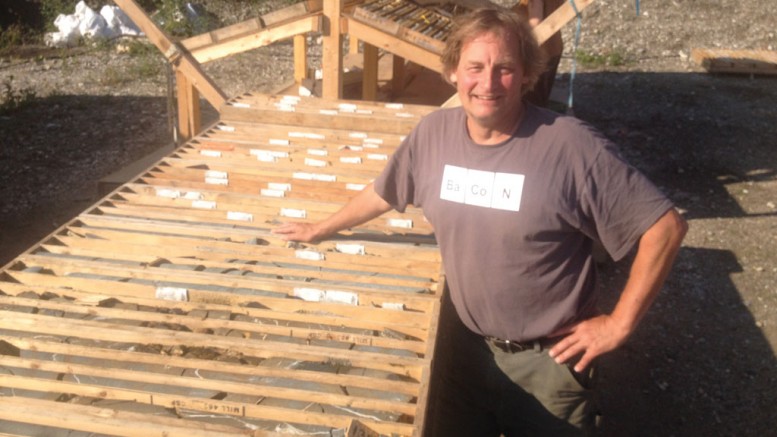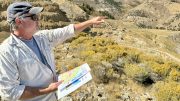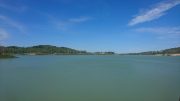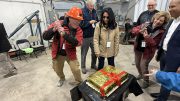DAWSON CITY, YUKON — Klondike Gold’s (TSXV: KG) president and CEO Peter Tallman reckons his company may have found the motherlode just 20 km south of the prolific Klondike goldfields, outside Yukon’s historic Dawson City, where past production yielded over 20 million oz. of placer gold.
The company has been drilling at its 138 sq. km Lone Star property since May, where a recent hole into the Nugget zone returned 5.1 grams gold per tonne over 14.3 metres in quartz veins hosted within mafic schists — the same rocks that flank the once bustling, placer mining town.
The Northern Miner caught up with Tallman at the company’s core shack outside Dawson to look at the rocks and discuss why he’s convinced he knows where the gold is.

Drill core boxes at the Eldorado Creek camp of Klondike Gold’s Lone Star gold property near Dawson City, Yukon. Credit: Klondike Gold.
“In 2014, I was looking at the regional geophysical map from the Yukon Geological Survey, and there’s an obvious fault system that cuts the Klondike schist within the goldfields,” he says. “There are a whole series of horsetail fractures that extend into Eldorado creek, the richest portion of the goldfields, and I thought, ‘well, that has to be the source of the Klondike, that’s what brought the gold.’”
Tallman laid the data alongside placer claims and found a pattern between mining and where the prospective faults crosscut the valleys.
“There are so many instances where these faults cut a creek, and downstream there are productive placer claims, whereas upstream there’s nothing … that’s a demonstrable source of Klondike gold right there,” he says. “And those structures intercept our entire property, so the question we have right now is: Where can we go in the geology to find something of economic size?”
Tallman says Klondike is the first company to fully assess the Nugget zone target, where mineralization occurs within two zones of parallel, east-trending quartz veins that average 5 metres wide.
Bulldozer trenching in the early 1990s and in 2005 uncovered the veins, but follow-up drilling in three holes in 2007 by Klondike, under former management, missed the target because they were drilled parallel to mineralization.
“They were basically drilling down the snout of these quartz vein systems, so they never found any continuity to the mineralization, nor could they figure out the geology,” he says. “If this was Timmins, and there’s an outcrop with visible gold, there would have been 20 drill holes plugged into it at least, and there’s hardly any work done here.”
Tallman stepped in as the company’s president and CEO in 2014, handpicked by Vancouver-based financier Frank Giustra, who has a 20% stake in the company.
“Giustra asked me to look at the property and more or less give him an indication of what kind of potential was still there,” he says. “My answer to him was that there’s huge potential. The Yukon was the flavour of the day when Underworld Resources discovered the Golden Saddle deposit and Kinross Gold took over … the project has been orphaned in the middle of nowhere, but if it had been found on the outskirts of Dawson, on a road with power, it would’ve already been mined.”
Golden Saddle has an inferred resource of 9.8 million tonnes of 2.67 grams gold for 840,000 oz. gold.
In his first year, Tallman settled the company’s debts, disposed of its non-core assets, consolidated 100% ownership of key claims and rolled back the stock.
Under the new management, Klondike conducted its first pass on drilling at Nugget last year, targeting surface mineralization in chip samples, which returned up to 8 grams gold over 4.3 metres, and 13 other samples that ranged between 5 and 30.5 grams gold.
The 400-metre, six-hole program intercepted two east-trending veins over a 100-metre strike length, which returned true thickness intervals of 7.7 metres of 4.6 grams gold, 6.1 metres of 5.3 grams gold and 3 metres of 5.7 grams gold.
The current program is working to extend the mineralization and test targets at depth and along strike, by drilling 11 holes totalling 1,000 metres. The latest drill results have doubled the mineralization strike to 200 metres, and Tallman says mineralization appears to gain strength to the east.
“The veins are separated by 10 metres of intervening material, but the easternmost holes show that the two zones have coalesced, and the entire interval is mineralized,” he says. “It’s not about individual veins, but it’s the volume of veins that makes it. So what we’re looking for are cases where lots of veins were generated and what kind of geological controls they have, so we can fine-tune our targeting criteria in future programs.”
The veins occur in the hanging wall of a fault plugged with young mafic dykes, which Tallman predicts may link up with a larger structure 200 metres east that falls in line with nearby productive placer creeks.
He notes there are two placer gold sources in the Klondike, and refers to the goldfields as “the largest, unexplained geochemical gold anomaly on the planet.”
The first source resulted from an event that occurred 3.5 million years ago, when a glacial lobe — which had blocked off the Yukon River farther south and created a “bathtub” of water over the Klondike — catastrophically broke.
“The Yukon River was flowing into B.C., but the dam created by the glacier undercut the river, so when it broke it was like pulling the plug on a bathtub, and it all turned around and flushed out to Alaska,” he says. “The water eroded away the soft mica in the schists and left behind the heavier material like the gold and quartz, which are the white channel gravels mined all around the Klondike.”

Klondike Gold’s 2016 drill plan map for the Nugget zone at its Lone Star gold property in the Yukon. Credit: Klondike Gold.
Since then, he says, the neighbouring creeks have cut away the bedrock and redeposited the gold farther downstream, making the second source of placer gold in the region.
“The white channel gravel came locally from the schists, it’s basically a big bulk sample of the whole area,” he says. “But the gold in individual creeks, particularly up Eldorado, directly comes from bedrock sources, and those we can trace.”
Tallman adds that studies out of the University of British Columbia suggest the white channel gravels represent an erosional surface up to 500 metres thick. He says the figure may be more like 200 metres, but this impact means less in the bigger picture.
“If there’s an orogenic vein system — which we know can extend to 7 km and more in the vertical — then we know there’s an immense amount of gold still trapped in the rocks somewhere. All I want to do is find at least a million ounces herded up in the corner somewhere, and the odds of that here are really good.”
Klondike has traded within a 52-week range of 8¢ to 42¢ per share, and closed at 32¢ per share at press time. The company has 46 million shares outstanding for a $14.7-million market capitalization.






“There is ‘Go-Old’ in them there hills…(quote herein), ‘the white channel gravels mined all around the Klondike.’
-Pure unrefined: Go..Old : Worth The Takin.’ Go – Old…”
Yeeeee-Hawwwww… !!!